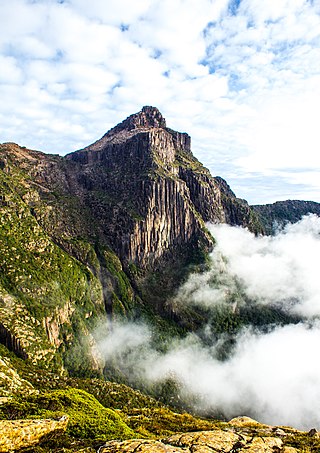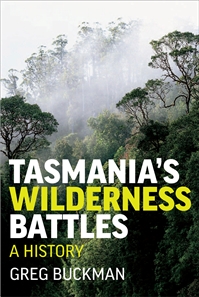
Conservation in Australia is an issue of state and federal policy. Australia is one of the most biologically diverse countries in the world, with a large portion of species endemic to Australia. Preserving this wealth of biodiversity is important for future generations. 25% of Australia is managed for conservation.

Robert James Brown is an Australian former politician, medical doctor and environmentalist. He was a senator and the parliamentary leader of the Australian Greens. Brown was elected to the Australian Senate on the Tasmanian Greens ticket, joining with sitting Greens Western Australia senator Dee Margetts to form the first group of Australian Greens senators following the 1996 federal election. He was re-elected in 2001 and in 2007. He was the first openly gay member of the Parliament of Australia and the first openly gay leader of an Australian political party.

Lake Pedder, once a glacial outwash lake, is a man-made impoundment and diversion lake located in the southwest of Tasmania, Australia. In addition to its natural catchment from the Frankland Range, the lake is formed by the 1972 damming of the Serpentine and Huon rivers by the Hydro Electric Commission of Tasmania for the purposes of hydroelectric power generation.

The Tasmanian Greens are a political party in Australia which developed from numerous environmental campaigns in Tasmania, including the flooding of Lake Pedder and the Franklin Dam campaign. They form a part of the Australian Greens.

The Franklin Dam or Gordon-below-Franklin Dam project was a proposed dam on the Gordon River in Tasmania, Australia, that was never constructed. The movement that eventually led to the project's cancellation became one of the most significant environmental campaigns in Australian history.

The Gordon River is a major perennial river located in the central highlands, south-west, and western regions of Tasmania, Australia.

Hydro Tasmania, known for most of its history as the Hydro-Electric Commission (HEC) or The Hydro, is the trading name of the Hydro-Electric Corporation, a Tasmanian Government business enterprise which is the predominant electricity generator in the state of Tasmania, Australia. The Hydro was originally oriented towards hydro-electricity, due to Tasmania's dramatic topography and relatively high rainfall in the central and western parts of the state. Today Hydro Tasmania operates thirty hydro-electric and one gas power station, and is a joint owner in three wind farms.
Olegas Truchanas was a Lithuanian-Australian conservationist and nature photographer.

Gunns Limited was a major forestry enterprise located in Tasmania, Australia. It had operations in forest management, woodchipping, sawmilling and veneer production. The company was placed into liquidation in March 2013.
The Tasmanian Wilderness Society was a Tasmanian environmental group that started in 1976 in response to a proposal by the state's Hydro Electric Commission to construct a dam on the Gordon River, downstream from the Franklin River, that led to the Franklin Dam controversy. The group evolved from membership of the South West Tasmania Action Committee and members of the United Tasmania Group. It was active in public protest about the issues of Wilderness, the Franklin River and South West Tasmania.

South West Tasmania is a region in Tasmania that has evoked curiosity as to its resources over the duration of European presence on the island.

The Bell Bay Pulp Mill, also known as the Tamar Valley Pulp Mill or Gunns Pulp Mill, was a proposed $2.3 billion pulp mill in which the former Gunns Limited was planning to build in the Tamar Valley, near Launceston, Tasmania.

The 1972 Tasmanian state election was held on 22 April 1972 in the Australian state of Tasmania to elect 35 members of the Tasmanian House of Assembly. The election used the Hare-Clark proportional representation system — seven members were elected from each of five electorates.
Brenda Hean (1910-1972) was a member of the Lake Pedder Action Committee (LPAC) and a resident of Hobart, Tasmania who disappeared at the time of the flooding of Lake Pedder.
The Lake Pedder Action Committee was a Tasmanian environmental group.

The Upper Florentine Valley is a valley in the south of Tasmania, Australia, is an area recognised for its landscape and old growth forests. It is situated along the Gordon River Road near Maydena in the southwest of the island, roughly three hours drive from Hobart and comprises around 60 square kilometres (23 sq mi) of temperate rainforest and tall eucalypt forest. The Upper Florentine forms part of the Florentine catchment upstream (south) from Churchill Creek. Geographically it is an area of generally low relief valleys and flats. The area is a known habitat for threatened species of flora and fauna, including myrtle elbow orchid, grey goshawk, and spotted-tail quoll.

Beginning as a conservation movement, the environmental movement in Australia was the first in the world to become a political movement. Australia is home to United Tasmania Group, the world's first green party.

Tasmania's Wilderness Battles: A History is a 2008 book by environmentalist Greg Buckman, who has "spent [his life] fighting Tasmanian environmental battles." The book looks at the wilderness areas of Tasmania which have been the focus of extensive conflict over environmental issues. Buckman presents a record of some of the significant events in that conflict, primarily from the viewpoint of an environmentalist.
Alec Marr is an Australian conservationist and former Executive Director of the Wilderness Society (TWS) in Australia From 1998 to 2010. He has been a forest campaigner, lobbyist and international campaign advisor.
South West Tasmania Action Committee was a group started after the flooding of the lake in South West Tasmania known as Lake Pedder to create the Gordon Dam catchment.

















